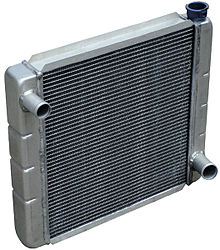Radiator

Radiators are heat exchangers used to transfer thermal energy from one medium to another for the purpose of cooling and heating. The majority of radiators are constructed to function in automobiles, buildings, and electronics. The radiator is always a source of heat to its environment, although this may be for either the purpose of heating this environment, or for cooling the fluid or coolant supplied to it, as for engine cooling.
Radiation and convection
One might expect the term "radiator" to apply to devices that transfer heat primarily by thermal radiation (see: infrared heating), while a device which relied primarily on natural or forced convection would be called a "convector". In practice, the term "radiator" refers to any of a number of devices in which a liquid circulates through exposed pipes (often with fins or other means of increasing surface area), notwithstanding that such devices tend to transfer heat mainly by convection and might logically be called convectors. The term "convector" refers to a class of devices in which the source of heat is not directly exposed.
Heating

Radiators are commonly used to heat buildings. In a central heating system, hot water or sometimes steam is generated in a central boiler, and circulated by pumps through radiators within the building.
There are two types: Single-pipe and double-pipe. The single-pipe radiators work with steam, while the double-pipe radiators work with steam or hot water. Double-pipe is the most sought-after type of vintage radiator.[1]
Engine cooling

Radiators are used for cooling internal combustion engines, chiefly in automobiles but also in piston-engined aircraft, railway locomotives, motorcycles, stationary generating plants or any similar use of such an engine.
They operate by passing a liquid coolant through the engine block, where it is heated, then through the radiator itself where it loses this heat to the atmosphere. This coolant is usually water-based, but may also be oil. It is usual for the coolant flow to be pumped, also for a fan to blow air through the radiator.
Electronics
As electronic devices become smaller yet more capable the problem of dispersing waste heat becomes more difficult. Tiny radiators known as heat sinks are used to convey heat from the electronic components into a cooling air stream.
Heat sinks, which dissipate thermal energy, should not be confused either with electric radiators or electromagnetic radiator elements, a subdivision of antenna in electronics which transmit or receive electromagnetic energy.
Theory of operation
From an engineering perspective, a radiator varies from an ideal black body by a factor, , called the emissivity, which is a spectrum-dependent property of any material. Commonly, a fluid thermal mass, containing the heat to be rejected, is pumped from the heat source to the radiator, where it conducts to the surface and radiates into the surrounding cooler medium. The rate of heat flow depends on the fluid properties, flow rate, conductance to the surface, and the surface area of the radiator. Watts per square metre are the SI units used for radiant emittance. If the system is not limited by the heat capacity of the fluid, or the thermal conductivity to the surface, then emittance, M is found by a fourth-power relation to the absolute temperature at the surface. The Stefan-Boltzmann constant is used to calculate it, as . Since heat may be absorbed as well as emitted, a radiator's ability to reject heat will depend on the difference in temperature between the surface and the surrounding environment. For particular operating temperatures, a system's overall heat flow may be given in thermal watts, abbreviated Wt.


